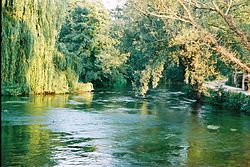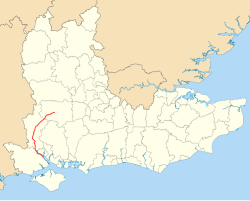River Test
| River Test | |
|---|---|
 The Test downstream of Sadler's Mill, Romsey | |
 River Test highlighted in red, shown in South East England | |
| Location | |
| Country | England |
| Counties | Hampshire |
| Physical characteristics | |
| Source | |
| • location | Ashe, near Overton, Hampshire, United Kingdom |
| • coordinates | 51°14′43″N 1°14′21″W / 51.2454°N 1.2392°W |
| • elevation | 90 m (300 ft) |
Notification | 1996[1] |
| Location map | Magic Map |
The River Test is a
Much of the Test is a 438-hectare (1,080-acre) biological Site of Special Scientific Interest.[1][3] It is part of the Solent and Southampton Water Ramsar site[4] and Special Protection Area.[5] The river is used for fly fishing for trout from its source to its tidal limit.[6]
Etymology
Recorded forms are Terstan from 877 and 901, Tarstan stream in 1045, Terstein 1234, and Test in 1425. If Common Brittonic, not Old English, all related dictionaries show three suitable words beginning with Tre- and none with extremely rare Ter-. There is precedent to such metathesis: as for the river Tern in the far west, from tren 'strong'.[7] If so it most likely relates to the Welsh tres (tumult, commotion, contention, uproar) or trais (force, might in older Welsh).[7] A close set of words (diversely conjugated and pronounced) in Old English is (f)irst(en), the meaning of which is as at present, first.
Course

The river rises near the village of
From Chilbolton the river goes through the villages of Leckford, Longstock, Stockbridge and Houghton to Mottisfont and Kimbridge, where the River Dun joins the flow. From here the village of Timsbury is passed, then through the grounds of Roke Manor before reaching the town of Romsey. On the western edge of Romsey, Sadler's Mill, an 18th-century watermill, sits astride the River Test.[9]
South of Romsey, the river passes the
Between Chilbolton and Redbridge, the river was once paralleled by the Andover Canal, which was itself converted to a railway in 1865, and then in turn abandoned. Most traces of the canal have disappeared, although the remains of a stretch can still be seen between Timsbury and Romsey.[11]
Ecology
This chalk stream has one of the richest fauna and flora of any lowland river in England. More than 100 species of flowering plant have been recorded along its banks and 232 invertebrate taxa in the river. It is also important for wetland birds, with breeding species including kingfishers, grey wagtails and little grebes.[12]
Water quality
The Environment Agency measure water quality of the river systems in England. Each is given an overall ecological status, which may be one of five levels: high, good, moderate, poor and bad. There are several components that are used to determine this, including biological status, which looks at the quantity and varieties of
Water quality of the River Test in 2019:
| Section | Ecological Status |
Chemical Status |
Overall Status |
Length | Catchment | Channel |
|---|---|---|---|---|---|---|
| Test (Upper)[14] | Good | Fail | Moderate | 14.803 km (9.198 mi) | 177.062 km2 (68.364 sq mi) | |
| Test - Bourne Rivulet to conf Dever[15] | Good | Fail | Moderate | 8.286 km (5.149 mi) | 32.01 km2 (12.36 sq mi) | |
| Test - conf Dever to conf Anton[16] | Good | Fail | Moderate | 3.869 km (2.404 mi) | 13.295 km2 (5.133 sq mi) | |
| Test - conf Anton to conf Dun[17] | Good | Fail | Moderate | 28.075 km (17.445 mi) | 56.88 km2 (21.96 sq mi) | |
| Test - conf Dun to Tadburn Lake[18] | Moderate | Fail | Moderate | 8.439 km (5.244 mi) | 19.045 km2 (7.353 sq mi) | heavily modified |
| Test (Lower)[19] | Good | Fail | Moderate | 8.579 km (5.331 mi) | 3.91 km2 (1.51 sq mi) |
In popular culture
The river features in
Tributaries
The following are the named tributaries of the River Test, listed in order upstream from Southampton Water.[21]
- Tanners Brook
- Wimpson stream (historically; due to the extension of the docks it now merges with Tanners Brook just before it reaches the Test)[22]
- River Blackwater
- River Dun
- Wallop Brook
- River Anton
- River Dever
- Bourne Rivulet
- River Swift
See also
- Rivers of the United Kingdom
References
- ^ a b c d "Designated Sites View: River Test". Sites of Special Scientific Interest. Natural England. Retrieved 18 May 2020.
- ^ "The Test Way". Hampshire County Council. Retrieved 7 September 2020.
- ^ "Map of River Test". Sites of Special Scientific Interest. Natural England. Retrieved 18 May 2020.
- ^ "Designated Sites View: Solent and Southampton Water". Ramsar Site. Natural England. Retrieved 23 April 2020.
- ^ "Designated Sites View: Solent and Southampton Water". Special Protection Areas. Natural England. Retrieved 23 April 2020.
- ^ Environment Agency (2006). Fact file on the River Test. Retrieved 8 February 2006. Archived 8 April 2005 at the Wayback Machine
- ^ a b Breeze, Andrew (1998). "The name of the River Test" (PDF). Proceedings of the Hampshire Field Club & Archaeological Society. 53: 226–227. Retrieved 27 January 2017.
- ISBN 0-319-23606-4.
- ISBN 0-319-23600-5.
- ISBN 0-319-23616-1.
- ^ Andover Town Central (2000–2006). The Andover Canal Archived 6 July 2008 at the Wayback Machine. Retrieved 9 February 2006.
- ^ "River Test citation" (PDF). Sites of Special Scientific Interest. Natural England. Retrieved 18 May 2020.
- ^ "Glossary (see Biological quality element; Chemical status; and Ecological status)". Catchment Data Explorer. Environment Agency. 17 February 2016.
 Text was copied from this source, which is available under an Open Government Licence v3.0. © Crown copyright.
Text was copied from this source, which is available under an Open Government Licence v3.0. © Crown copyright.
- ^ "Test (Upper)". Catchment Data Explorer. Environment Agency.
- ^ "Test - Bourne Rivulet to conf Dever". Catchment Data Explorer. Environment Agency.
- ^ "Test - conf Dever to conf Anton". Catchment Data Explorer. Environment Agency.
- ^ "Test - conf Anton to conf Dun". Catchment Data Explorer. Environment Agency.
- ^ "Test - conf Dun to Tadburn Lake". Catchment Data Explorer. Environment Agency.
- ^ "Test (Lower)". Catchment Data Explorer. Environment Agency.
- ^ a b Rock, Peter (15 May 2018). "On the Unsettling Allure of 'Watership Down'". The New York Times. Retrieved 3 April 2021.
- ISBN 0-319-22185-7.
- ^ Burgess, Lawrence (1982). The Streams and Watercourses Of Southampton. Friends of Old Southampton. p. 4.

